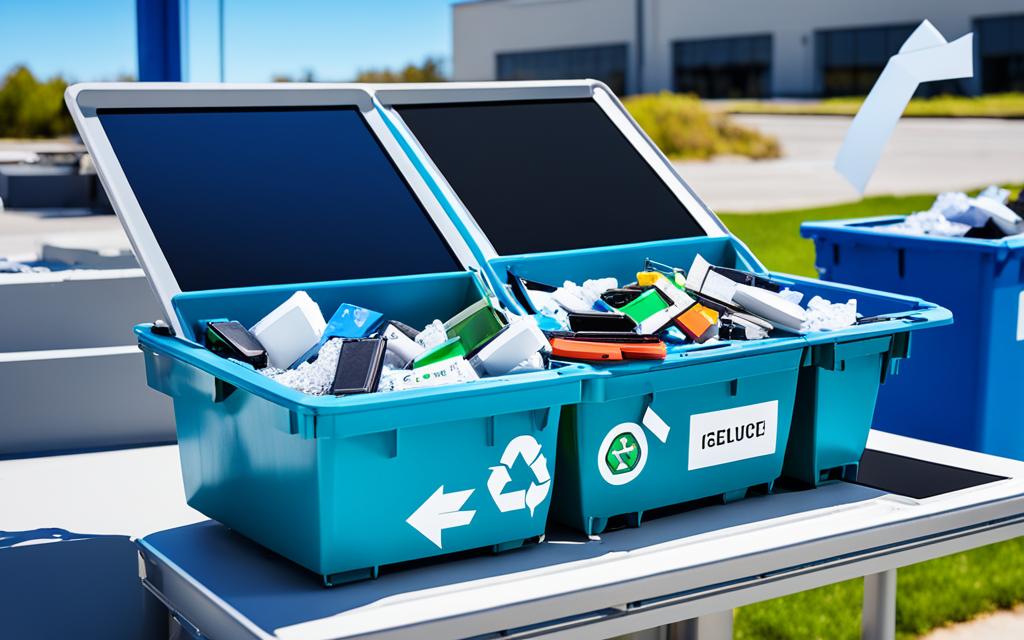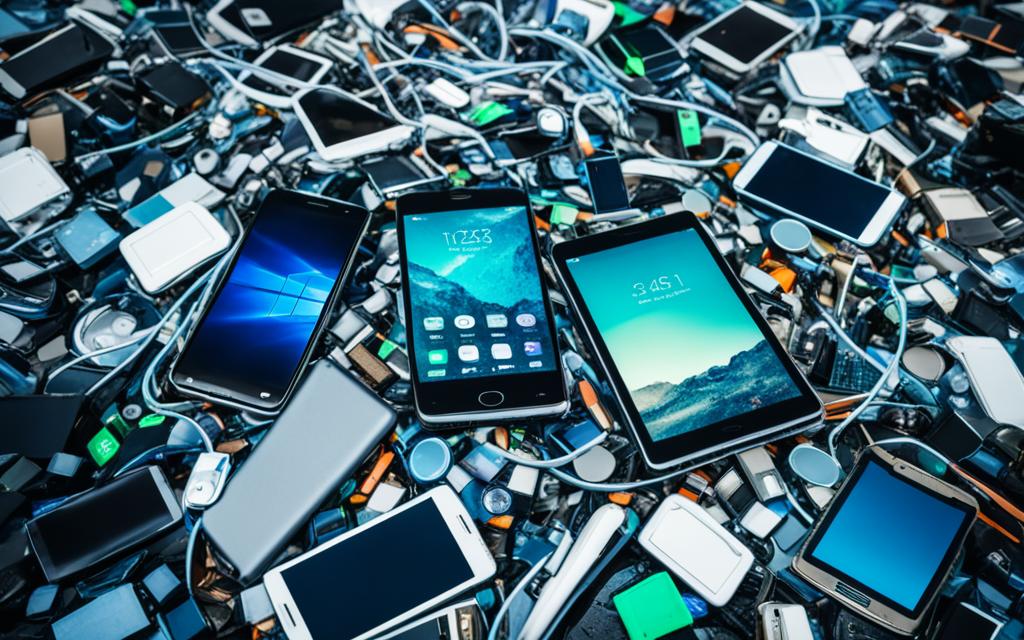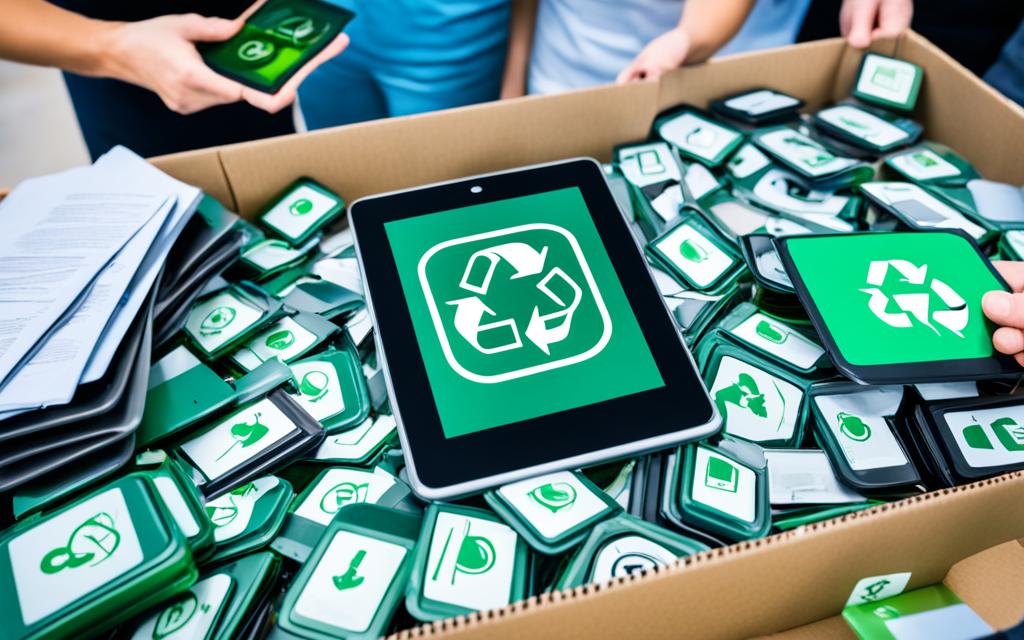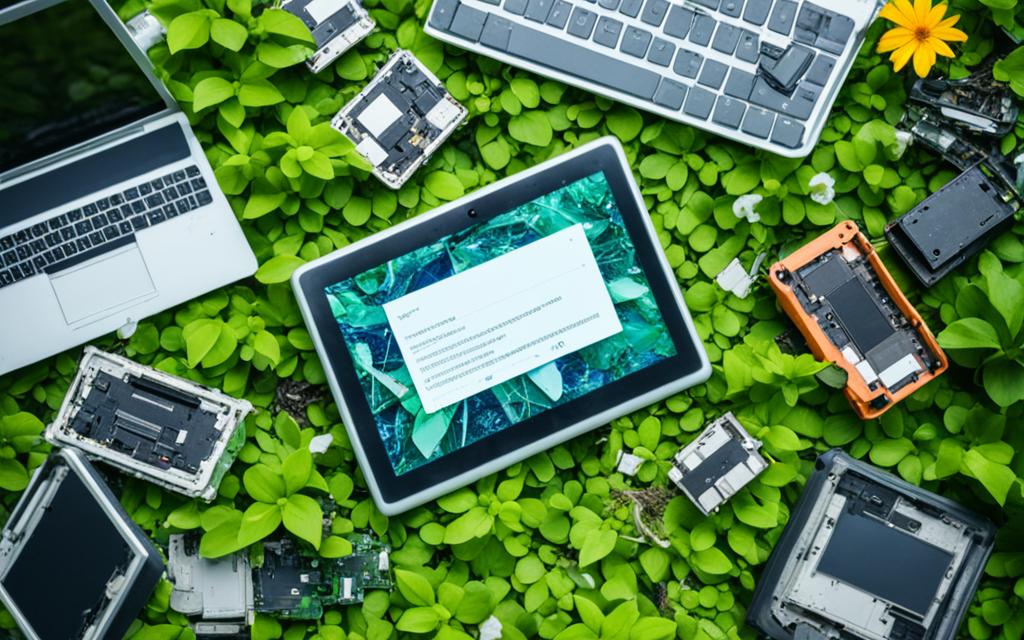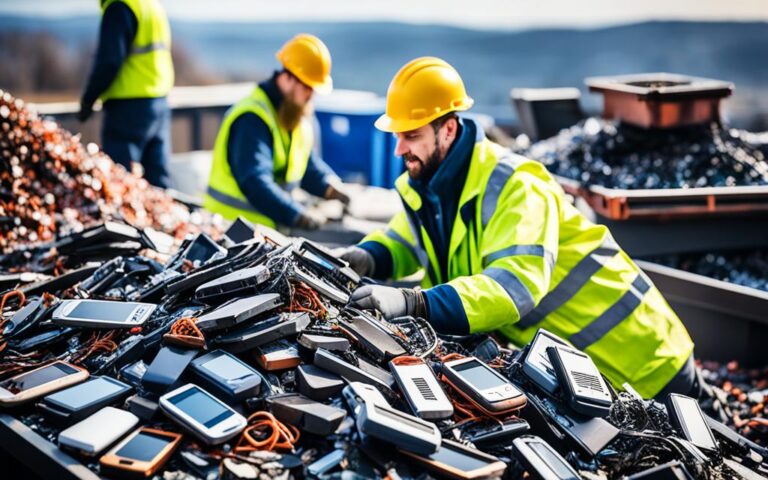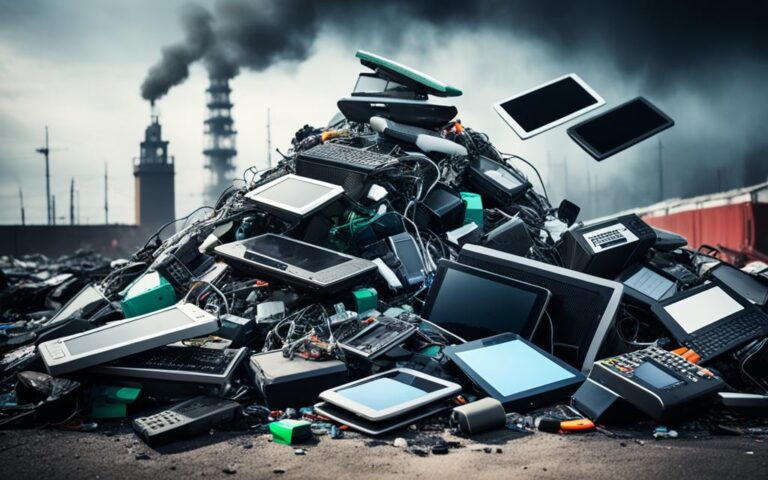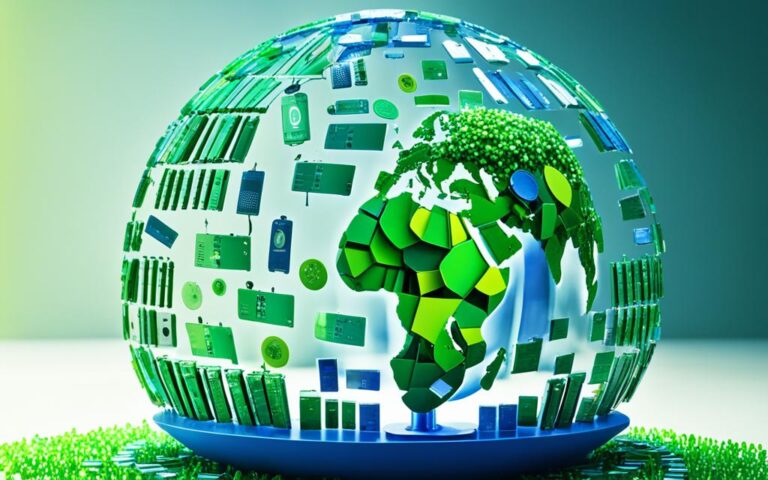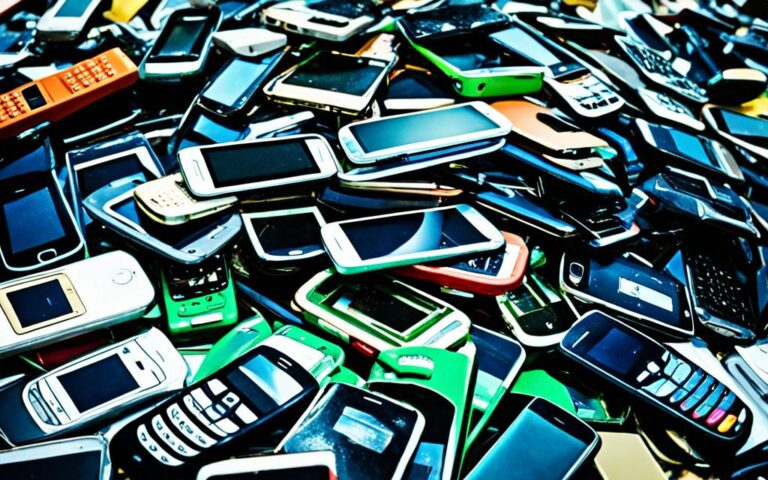Tablet Disposal: Environmental Risks and Safe Recycling Practices
Proper disposal of electronic devices is crucial to protect sensitive information and prevent environmental harm. Tablets, as electronic devices that store and process data, require special attention when being disposed of. It’s not just about ensuring the safety of personal information; it’s also about minimizing the environmental impact.
Today, we will explore the environmental risks associated with tablet disposal and provide you with guidelines for safe recycling practices. By following these practices, you can contribute to a cleaner and greener future.
Tablets contain valuable data that can be exploited if not disposed of properly. The improper disposal of tablets also contributes to the growing issue of electronic waste, which poses significant environmental risks. It’s time to take action and prioritize safe tablet disposal.
Join us as we delve into the importance of safe tablet disposal, effective methods for secure data removal, safe disposal options for out-of-date tablets, and the challenges and solutions in e-waste recycling. By the end of this article, you’ll have the knowledge you need to make informed choices when it comes to tablet disposal.
Importance of Safe Tablet Disposal
Proper disposal of electronic devices, including tablets, is of paramount importance to protect sensitive information and prevent cybercrime. Tablets store valuable data such as personal information, banking details, and login credentials. If not disposed of safely, this information can be exploited by malicious individuals or organizations. Therefore, it is crucial to follow best practices for tablet disposal to ensure the security and privacy of personal data.
However, the significance of safe tablet disposal extends beyond data security. The improper disposal of tablets contributes to the mounting issue of electronic waste, also known as e-waste. E-waste includes discarded electronic devices that pose environmental risks due to the toxic materials they contain, such as lead, mercury, and cadmium. When tablets are not disposed of properly, these harmful substances can leach into the soil and water sources, contaminating ecosystems and endangering human health.
To illustrate the scale of the electronic waste problem, let’s look at some statistics:
| Year | Electronic Waste Generated (in metric tonnes) |
|---|---|
| 2014 | 41.8 million |
| 2016 | 44.7 million |
| 2018 | 50 million |
| 2020 | 53.6 million |
As the table demonstrates, the amount of electronic waste generated has been steadily increasing over the years. This trend highlights the urgency to address the issue and adopt sustainable practices, including safe tablet disposal.
By following safe disposal practices, individuals not only protect their personal information but also contribute to a more sustainable future. Through responsible recycling, valuable resources from tablets can be recovered and reused, reducing the demand for raw materials and minimizing the ecological footprint associated with electronic production.
“Safe tablet disposal is not just about protecting your data; it’s about safeguarding the environment and creating a better world for future generations.”
By taking proactive steps towards safe tablet disposal, individuals can play a crucial role in reducing electronic waste and preserving the planet. The next section will explore the methods for secure data removal from tablets before disposal.
Data Removal Methods for Tablets
Before disposing of a tablet, it is essential to ensure that all personal data is securely removed. There are several reliable methods for data removal, including:
- Using disk cleaning software specifically designed for tablets. This software erases data by overwriting it with random patterns, making it impossible to recover.
- Performing a factory reset, also known as a hard reset, on the tablet. This process restores the device to its original factory settings, effectively wiping all personal data.
- Encrypting the tablet’s storage before performing a factory reset. Encryption scrambles the data, making it unreadable without the encryption key, even if someone manages to access the device’s storage.
It is recommended to use a combination of these methods to ensure complete data removal and protect sensitive information. By following these steps, individuals can dispose of tablets safely, minimizing the risk of data breaches and contributing to a safer digital environment.
Methods for Secure Data Removal
When disposing of a tablet, it is crucial to ensure that all sensitive information is permanently removed to prevent data breaches. There are several reliable methods for secure data removal that can be applied to tablets. By following these tablet sanitization methods, individuals can safeguard their personal data and protect against potential security risks.
Disk Cleaning Software
Disk cleaning software designed for computers is an effective tool for securely erasing data from tablets. This software uses advanced algorithms to overwrite the existing data on the device, making it virtually impossible to recover. By using disk cleaning software, individuals can ensure that their personal information, including passwords, financial records, and browsing history, is completely removed from the tablet.
Secure Erase Commands
Secure erase commands for hard drives are another method for secure data removal from tablets. These commands overwrite the data on the storage drive at a low-level, making it extremely difficult, if not impossible, to retrieve any previously stored information. Secure erase commands are typically available through the tablet’s operating system or specific software designed for secure data removal.
Disk Wiping Utilities
Disk wiping utilities for flash drives can be used to securely remove data from tablets with non-removable storage. These utilities overwrite the data on the tablet’s internal storage, leaving no traces of the previously stored information. Disk wiping utilities are available as standalone software or as part of comprehensive security suites, offering users a convenient way to sanitize their tablets before disposal.
Performing a Hard Reset
Performing a hard reset on smartphones and tablets is an effective method for secure data removal. This process involves restoring the device to its original factory settings, erasing all personal data and customized settings. However, it is important to note that a hard reset might not completely remove all data from the tablet, especially if it has a removable storage card. In such cases, utilizing additional sanitization methods is recommended.
By employing these methods for secure data removal, individuals can confidently dispose of their tablets, knowing that their personal information is appropriately safeguarded. It is essential to determine the most suitable method for each tablet based on its specifications and storage type. Taking the necessary steps to properly sanitize tablets not only protects sensitive data but also contributes to a safer digital environment.
Comparison of Tablet Sanitization Methods
| Method | Description | Pros | Cons |
|---|---|---|---|
| Disk Cleaning Software | Software designed to overwrite existing data on tablets | – Thorough and effective data removal – User-friendly interface |
– May require installation and setup – Some software may not support all tablet models |
| Secure Erase Commands | Commands that overwrite data at a low-level on tablet storage | – Built-in functionality on some tablets – Ensures comprehensive data removal |
– Availability may vary among tablet models – Command execution may be complex for non-technical users |
| Disk Wiping Utilities | Utilities specifically designed for securely wiping flash drive storage | – Wide range of available utilities – Ability to sanitize non-removable storage |
– Compatibility with tablet models may vary – Additional software installation required |
| Performing a Hard Reset | Restoring the tablet to its original factory settings | – Convenient built-in tablet feature – Resets all personalized settings |
– Data recovery still possible in some cases – Limited effectiveness for non-removable storage tablets |
Safe Disposal Options for Out-of-Date Tablets
When it’s time to bid farewell to your out-of-date tablet, it’s crucial to choose safe and eco-friendly options for disposal. Electronic waste, commonly known as e-waste, refers to discarded electronic devices that have reached the end of their useful life. Recycling these devices is essential to conserve natural resources and prevent environmental damage.
However, not all recycling facilities are created equal. To ensure responsible and sustainable e-waste management, it’s important to select a reputable and certified recycling facility.
Fortunately, many communities have designated e-waste drop-off locations where individuals can safely dispose of their outdated tablets. These drop-off locations often have specialized facilities and processes in place to handle electronic devices in an environmentally friendly manner.
In addition to local drop-off locations, there are national programs that accept electronic devices for safe disposal. One such example is the U.S. Drug Enforcement Administration’s National Prescription Drug Take Back Day. Although primarily focused on prescription drugs, this program also accepts electronic devices, including tablets. Participating in these initiatives not only ensures the proper management of e-waste but also contributes to the overall reduction of electronic waste.
By utilizing these safe disposal options, individuals can play an active role in reducing the environmental impact of discarded tablets and promoting the responsible recycling of electronic devices.
Benefits of Safe Disposal Options for Out-of-Date Tablets:
- Protects the environment by minimizing electronic waste
- Prevents hazardous materials from seeping into the soil and water
- Contributes to the conservation of natural resources
- Supports the development of a sustainable recycling infrastructure
A Comparison of Safe Disposal Options for Out-of-Date Tablets
| Disposal Option | Description | Key Features |
|---|---|---|
| Local E-Waste Drop-off Locations | Designated collection points within communities |
|
| National Prescription Drug Take Back Day | A nationwide initiative for safe prescription drug disposal |
|
By leveraging these safe disposal options, individuals can actively contribute to the proper e-waste management and environmental sustainability.
Challenges and Solutions in E-Waste Recycling
The increasing volume of e-waste poses significant challenges to the recycling industry. With technology becoming more integrated into our lives and the shortened lifespan of electronic devices, proper recycling practices are essential for resource recovery and environmental protection. However, informal recycling practices, inadequate regulations, and illegal e-waste exports to developing countries contribute to environmental pollution and health hazards.
To address these challenges, there is a need for stricter regulations, extended producer responsibility, and increased awareness of the importance of sustainable e-waste recycling. By implementing these solutions, we can mitigate the negative impacts of e-waste and create a more sustainable future.
“The e-waste problem demands immediate action. It’s not just an environmental issue but a global responsibility to ensure the proper disposal and recycling of electronic devices. By tackling the challenges head-on and adopting sustainable solutions, we can pave the way for a cleaner and healthier planet.” – Jane Thompson, Environmental Activist
The Challenge of Informal Recycling Practices
One of the major challenges in e-waste recycling is the prevalence of informal recycling practices. In many parts of the world, e-waste is handled by unregulated vendors who lack the knowledge and infrastructure to safely handle and dispose of electronic devices. As a result, valuable materials are often lost, hazardous substances are released into the environment, and workers are exposed to dangerous conditions.
The Need for Stricter Regulations
To combat the challenges posed by informal recycling practices, stricter regulations need to be implemented. These regulations should focus on establishing standards for responsible e-waste management, ensuring that recycling facilities adhere to proper safety protocols, and imposing penalties for non-compliance. By enforcing these regulations, we can improve the overall efficiency and safety of e-waste recycling.
Extended Producer Responsibility
Extended producer responsibility (EPR) is another crucial solution to the challenges in e-waste recycling. EPR places the responsibility for the management and disposal of electronic devices on the manufacturers. By holding manufacturers accountable for the entire lifecycle of their products, including their end-of-life disposal, EPR encourages the development of more sustainable and recyclable devices. This approach not only reduces the burden on consumers but also incentivizes manufacturers to design products with circularity in mind.
| Challenges | Solutions |
|---|---|
| Informal recycling practices | Stricter regulations |
| Inadequate regulations | Extended producer responsibility |
| Illegal e-waste exports | Increased awareness of sustainable e-waste recycling |
Increased Awareness of Sustainable E-Waste Recycling
An essential element in addressing the e-waste problem is raising awareness about the importance of sustainable e-waste recycling. Educating the general public, businesses, and policymakers about the environmental and health risks associated with improper e-waste disposal is crucial. By promoting consumer awareness and providing accessible recycling options, we can encourage individuals and organizations to make sustainable choices and contribute to a circular economy.
Conclusion
Proper disposal of tablets and other electronic devices is fundamental to safeguarding sensitive information and mitigating environmental risks. By adhering to safe recycling practices, individuals can actively contribute to a more sustainable and responsible approach to technology. One crucial aspect is securely removing data from the tablets before disposal. Utilising certified e-waste recycling programs is also key in ensuring that the recycling process is conducted in an environmentally friendly manner.
The collaboration between individuals, manufacturers, and policymakers is vital in addressing the challenges associated with e-waste management and promoting sustainable recycling practices. By working together, we can protect our planet and pave the way for a healthier future for generations to come. It is our collective responsibility to take action and adopt safe and responsible tablet disposal practices, contributing to a more sustainable world.
Let us unite and commit ourselves to proper tablet disposal and safe recycling practices. Together, we can make a significant difference and create a cleaner, greener future.
FAQ
Why is proper disposal of tablets important?
Proper disposal of tablets is important to protect sensitive information and prevent environmental harm. Tablets contain valuable data that can be exploited if not disposed of properly, and the improper disposal of tablets contributes to the growing issue of electronic waste.
How can I permanently remove data from my tablet before disposal?
There are several effective methods for permanently removing data from tablets before disposal. These methods include using disk cleaning software, secure erase commands, disk wiping utilities, and performing a hard reset on smartphones and tablets. It is essential to follow the appropriate process to ensure all sensitive information is erased.
What are safe and eco-friendly options for disposing of out-of-date tablets?
When disposing of out-of-date tablets, it is important to choose safe and eco-friendly options. Many communities have designated e-waste drop-off locations, and there are also national programs that accept electronic devices for safe disposal, such as the U.S. Drug Enforcement Administration’s National Prescription Drug Take Back Day.
What are the challenges in e-waste recycling?
The increasing volume of e-waste poses significant challenges to the recycling industry. Informal recycling practices, inadequate regulations, and illegal e-waste exports to developing countries contribute to environmental pollution and health hazards.
How can we address the challenges of e-waste recycling?
To address the challenges of e-waste recycling, there is a need for stricter regulations, extended producer responsibility, and increased awareness of the importance of sustainable e-waste recycling.
What can I do to contribute to safe tablet disposal and responsible recycling?
By following safe recycling practices, such as securely removing data and utilizing certified e-waste recycling programs, individuals can contribute to a more sustainable and responsible approach to technology. It is crucial for individuals, manufacturers, and policymakers to work together to promote sustainable recycling practices and protect the environment.

